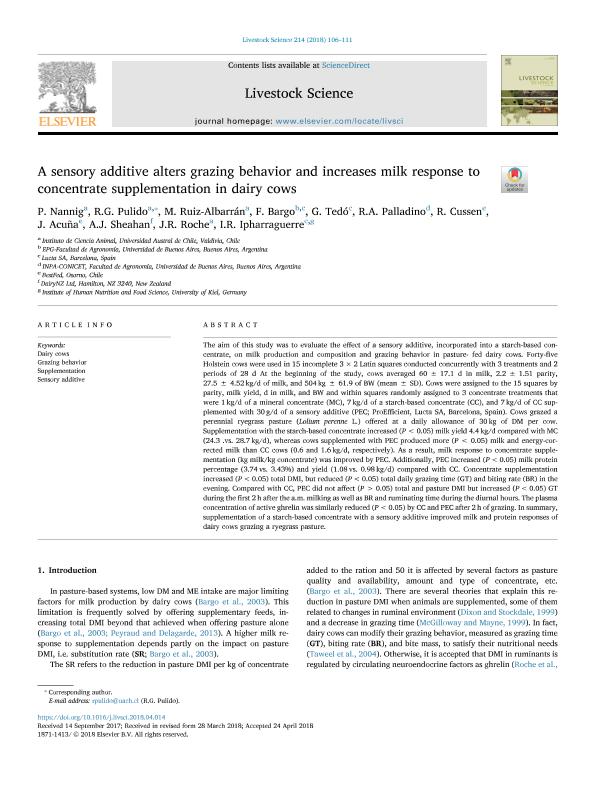Artículo
A sensory additive alters grazing behavior and increases milk response to concentrate supplementation in dairy cows
Nannig, P.; Pulido, R. G.; Ruiz Albarrán, M.; Bargo, Fernando; Tedó, G.; Palladino, Rafael Alejandro ; Cussen, R.; Acuña, J.; Sheahan, A. J.; Roche, J. R.; Ipharraguerre, I. R.
; Cussen, R.; Acuña, J.; Sheahan, A. J.; Roche, J. R.; Ipharraguerre, I. R.
 ; Cussen, R.; Acuña, J.; Sheahan, A. J.; Roche, J. R.; Ipharraguerre, I. R.
; Cussen, R.; Acuña, J.; Sheahan, A. J.; Roche, J. R.; Ipharraguerre, I. R.
Fecha de publicación:
08/2018
Editorial:
Elsevier Science
Revista:
Livestock Science
ISSN:
1871-1413
Idioma:
Inglés
Tipo de recurso:
Artículo publicado
Clasificación temática:
Resumen
The aim of this study was to evaluate the effect of a sensory additive, incorporated into a starch-based concentrate, on milk production and composition and grazing behavior in pasture- fed dairy cows. Forty-five Holstein cows were used in 15 incomplete 3 × 2 Latin squares conducted concurrently with 3 treatments and 2 periods of 28 d At the beginning of the study, cows averaged 60 ± 17.1 d in milk, 2.2 ± 1.51 parity, 27.5 ± 4.52 kg/d of milk, and 504 kg ± 61.9 of BW (mean ± SD). Cows were assigned to the 15 squares by parity, milk yield, d in milk, and BW and within squares randomly assigned to 3 concentrate treatments that were 1 kg/d of a mineral concentrate (MC), 7 kg/d of a starch-based concentrate (CC), and 7 kg/d of CC supplemented with 30 g/d of a sensory additive (PEC; ProEfficient, Lucta SA, Barcelona, Spain). Cows grazed a perennial ryegrass pasture (Lolium perenne L.) offered at a daily allowance of 30 kg of DM per cow. Supplementation with the starch-based concentrate increased (P < 0.05) milk yield 4.4 kg/d compared with MC (24.3.vs. 28.7 kg/d), whereas cows supplemented with PEC produced more (P < 0.05) milk and energy-corrected milk than CC cows (0.6 and 1.6 kg/d, respectively). As a result, milk response to concentrate supplementation (kg milk/kg concentrate) was improved by PEC. Additionally, PEC increased (P < 0.05) milk protein percentage (3.74 vs. 3.43%) and yield (1.08 vs. 0.98 kg/d) compared with CC. Concentrate supplementation increased (P < 0.05) total DMI, but reduced (P < 0.05) total daily grazing time (GT) and biting rate (BR) in the evening. Compared with CC, PEC did not affect (P > 0.05) total and pasture DMI but increased (P < 0.05) GT during the first 2 h after the a.m. milking as well as BR and ruminating time during the diurnal hours. The plasma concentration of active ghrelin was similarly reduced (P < 0.05) by CC and PEC after 2 h of grazing. In summary, supplementation of a starch-based concentrate with a sensory additive improved milk and protein responses of dairy cows grazing a ryegrass pasture.
Palabras clave:
DAIRY COWS
,
GRAZING BEHAVIOR
,
SENSORY ADDITIVE
,
SUPPLEMENTATION
Archivos asociados
Licencia
Identificadores
Colecciones
Articulos(INPA)
Articulos de UNIDAD EJECUTORA DE INVESTIGACIONES EN PRODUCCION ANIMAL
Articulos de UNIDAD EJECUTORA DE INVESTIGACIONES EN PRODUCCION ANIMAL
Citación
Nannig, P.; Pulido, R. G.; Ruiz Albarrán, M.; Bargo, Fernando; Tedó, G.; et al.; A sensory additive alters grazing behavior and increases milk response to concentrate supplementation in dairy cows; Elsevier Science; Livestock Science; 214; 8-2018; 106-111
Compartir
Altmétricas



